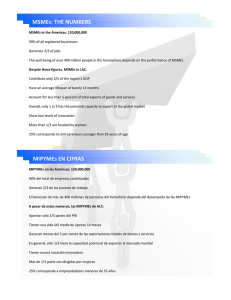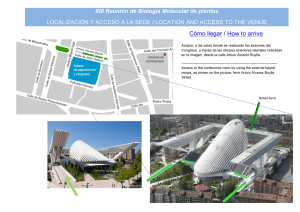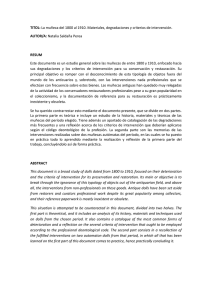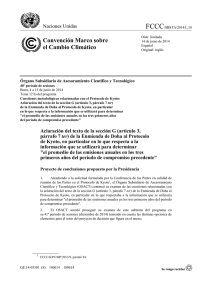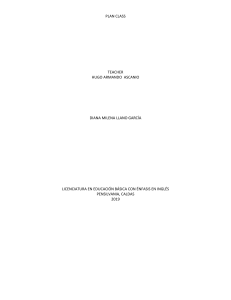Convención Marco sobre el Cambio Climático
Anuncio
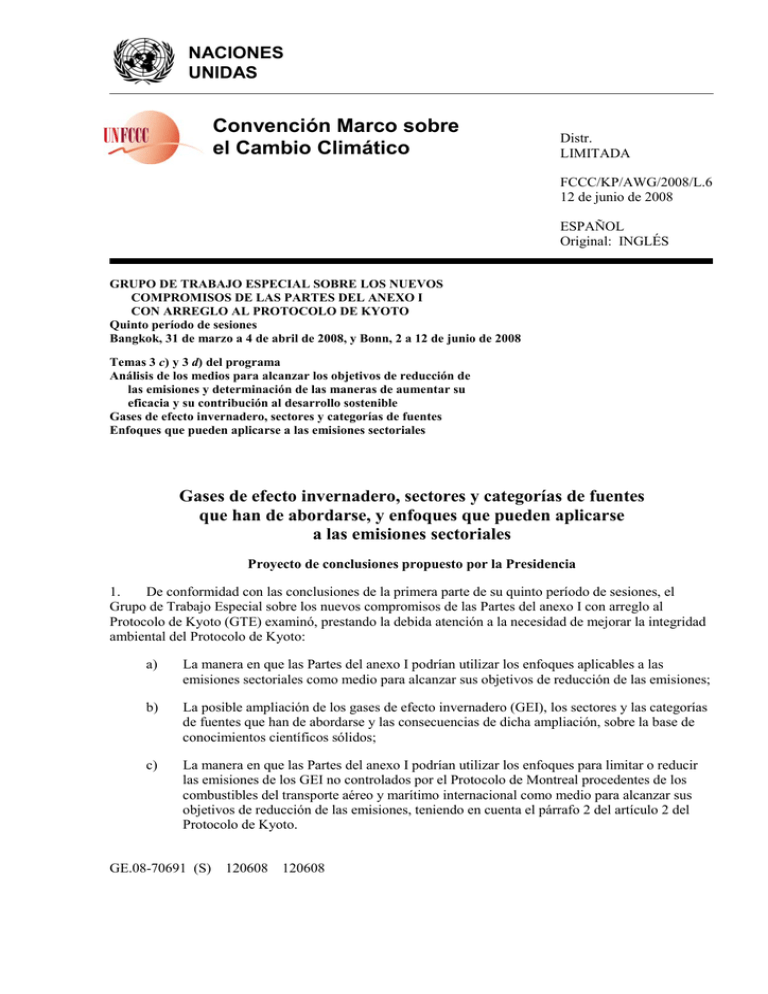
NACIONES UNIDAS Convención Marco sobre el Cambio Climático Distr. LIMITADA FCCC/KP/AWG/2008/L.6 12 de junio de 2008 ESPAÑOL Original: INGLÉS GRUPO DE TRABAJO ESPECIAL SOBRE LOS NUEVOS COMPROMISOS DE LAS PARTES DEL ANEXO I CON ARREGLO AL PROTOCOLO DE KYOTO Quinto período de sesiones Bangkok, 31 de marzo a 4 de abril de 2008, y Bonn, 2 a 12 de junio de 2008 Temas 3 c) y 3 d) del programa Análisis de los medios para alcanzar los objetivos de reducción de las emisiones y determinación de las maneras de aumentar su eficacia y su contribución al desarrollo sostenible Gases de efecto invernadero, sectores y categorías de fuentes Enfoques que pueden aplicarse a las emisiones sectoriales Gases de efecto invernadero, sectores y categorías de fuentes que han de abordarse, y enfoques que pueden aplicarse a las emisiones sectoriales Proyecto de conclusiones propuesto por la Presidencia 1. De conformidad con las conclusiones de la primera parte de su quinto período de sesiones, el Grupo de Trabajo Especial sobre los nuevos compromisos de las Partes del anexo I con arreglo al Protocolo de Kyoto (GTE) examinó, prestando la debida atención a la necesidad de mejorar la integridad ambiental del Protocolo de Kyoto: a) La manera en que las Partes del anexo I podrían utilizar los enfoques aplicables a las emisiones sectoriales como medio para alcanzar sus objetivos de reducción de las emisiones; b) La posible ampliación de los gases de efecto invernadero (GEI), los sectores y las categorías de fuentes que han de abordarse y las consecuencias de dicha ampliación, sobre la base de conocimientos científicos sólidos; c) La manera en que las Partes del anexo I podrían utilizar los enfoques para limitar o reducir las emisiones de los GEI no controlados por el Protocolo de Montreal procedentes de los combustibles del transporte aéreo y marítimo internacional como medio para alcanzar sus objetivos de reducción de las emisiones, teniendo en cuenta el párrafo 2 del artículo 2 del Protocolo de Kyoto. GE.08-70691 (S) 120608 120608 FCCC/KP/AWG/2008/L.6 página 2 2. El GTE observó que las Partes del anexo 1 podrían utilizar los enfoques aplicables a las emisiones sectoriales como medio para alcanzar sus objetivos de reducción de las emisiones, pero no para sustituirlos. 3. El GTE tomó nota de las opiniones expresadas por las Partes en relación con estos subtemas del programa, recopiladas por la Presidencia del GTE bajo su responsabilidad, que se anexan a estas conclusiones. 4. El GTE convino en proseguir su labor, conforme a su mandato y su programa de trabajo, en la primera parte de su sexto período de sesiones (agosto de 2008) de modo que pudieran adoptarse las conclusiones en ese período de sesiones. FCCC/KP/AWG/2008/L.6 página 3 Annex [ENGLISH ONLY] Views of Parties compiled by the Chair of the Ad Hoc Working Group on Further Commitments for Annex I Parties under the Kyoto Protocol on possible approaches targeting sectoral emissions and on greenhouse gases, sectors and source categories to be covered This annex is the compilation of views of Parties and does not prejudge any actions by the Ad Hoc Working Group on Further Commitments for Annex I Parties under the Kyoto Protocol (AWG-KP). Possible approaches targeting sectoral emissions 1. Approaches targeting sectoral emissions in Annex I Parties could assist Annex I Parties in reaching their national emission reduction targets and could cover both producing and consuming sectors. These approaches should lead to a real benefit for the climate. 2. Approaches targeting sectoral emissions, within the mandate of the AWG-KP and according to its work programme, should not: • • • Replace national targets of Annex I Parties; Lead to commitments for non-Annex I Parties; Constitute a means of arbitrary or unjustifiable discrimination or a disguised restriction on international trade. 3. Types of approaches targeting sectoral emissions, within the mandate of the AWG-KP and according to its work programme, include: • • • • Bottom-up sectoral analysis to inform the discussion on mitigation potentials of Annex I Parties;1 Cooperative sectoral approaches supported and enabled by finance and technology; Sectoral crediting in non-Annex I Parties;2 Complementary sector-specific goals for Annex I Parties. Greenhouse gases, sectors and source categories to be covered 1. Ensure a comprehensive coverage of greenhouse gases (GHGs), sectors and source categories based on the Fourth Assessment Report of the Intergovernmental Panel on Climate Change (AR4). 2. A. 1. Ensure the environmental integrity of the Kyoto Protocol. Greenhouse gases Consider possible implications of adding new gases for: 1 Relevant for discussions on mitigation potential. 2 Relevant for discussions under emissions trading and the project-based mechanisms under agenda item 3(a). FCCC/KP/AWG/2008/L.6 página 4 • • • Mitigation potentials of Annex I Parties; The carbon market, in particular the supply and demand for tradable units under the Kyoto Protocol; National action in Annex I Parties. 2. Based on the above implications, consider adding to Annex A to the Kyoto Protocol, taking into account the availability of methodologies for estimating anthropogenic emissions and global warming potentials or any other metric: • • B. Then new GHGs to the group of hydrofluorocarbons and perfluorocarbons referred to the AR4; Then new GHGs or groups of GHGs including fluorinated ethers and perfluoropolyethers referred to in the AR4. Sectors and source categories 1. Consider the possible implications of broadening the coverage of sectors and source categories, taking into account: • • • The results of consideration of adding new GHGs or groups of GHGs; The results of consideration of the application of the 2006 IPCC Guidelines for National Greenhouse Gas Inventories; The results of the consideration of the definitions, modalities, rules and guidelines for the treatment of land use, land-use change and forestry (LULUCF) in the second commitment period. 2. Based on the above implications, make any necessary changes to the coverage of sectors and source categories under Annex A to the Kyoto Protocol. [Emissions from aviation and maritime bunker fuels 1. Limiting or reducing emissions from aviation and marine bunker fuels as a means for Annex I Parties to reach their emission reduction targets in accordance with Article 2, paragraph 2, of the Kyoto Protocol. 2. Scope of limiting or reducing emissions from aviation and marine bunker fuels as a means for Annex I Parties to reach their emission reduction targets in accordance with Article 2, paragraph 2, of the Kyoto Protocol: • • • 3. The International Civil Aviation Organization (ICAO) and International Maritime Organization (IMO) to take the lead; emissions to continue to be reported separately from national totals in accordance with the UNFCCC and Kyoto Protocol reporting guidelines; UNFCCC to agree on mitigation objectives; ICAO and IMO to implement these objectives; UNFCCC to take the lead by allocating emissions to national totals; ICAO and IMO to provide technical expertise. Need for progress on discussions on Article 2, paragraph 3, of the Kyoto Protocol. 4. Apply economic instruments to emissions from aviation and marine bunker fuels as a source of revenue to finance, inter alia, adaptation and reduction of emissions from deforestation and forest degradation in developing countries.] -----



